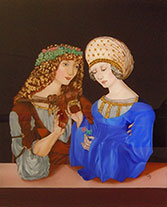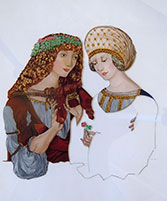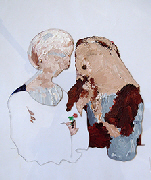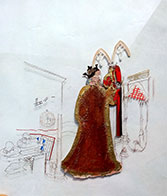Mathilda De Carpentry is a French painter who specializes in reverse glass painting (also known as fixé sous verre). Her work is distinguished by its medieval and oriental inspiration, creating pieces that recall illuminated manuscripts.
She uses the fixé sous verre technique with great precision, painting the subject "in reverse," from the details to the background. This method, which allows for no retouching, demands great rigor and extreme patience. Her works are the result of long labor, sometimes several months for a single piece.
Mathilda De Carpentry's work is nourished by two main sources:
• Western Art: She draws inspiration from medieval imagery for her hunting scenes, enchanted forests, or legendary characters like Tristan.
• Oriental Illuminations: She integrates elements of Persian, Chinese, or "Thousand and One Nights" art, giving her works a rich and shimmering appearance.
The glass, as a medium, gives her works a particular brilliance, enhancing the luster of the colors. Her blues, greens, and golds acquire the sparkle of precious stones, creating a universe teeming with life and details.
Thus it is not possible to put a light behind the glass.
« Illuminations », those painted letters or miniatures with which they are ornamented. Under Mathilda de Carpentry’s skilled fingers, illuminations have now taken on a completely new form of life. Using this ancient art as a basis and applying it to scenes mainly related to the Middle Ages, Mathilda de Carpentry has created a unique style in which the glass itself plays the primary role. It is by painting on the glass (from behind) that the artist allows her modern-day imagination to run free in the service of this bygone art, revealing its forms and colours in ways which often totally surprise (and delight)the usually blase contemporary audience.
The increasing interest shown by the public, collectors and museums for reverse painting on glass opens a new chapter in the history of Decorative Art.
William Laurent, Art Critic









